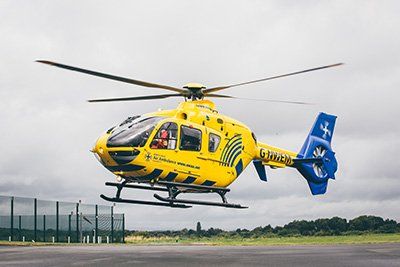Forget BREXIT, is Europe Leaving the UK Behind on “PinS”?
With BREXIT only a matter of weeks away, we consider how our European aviation neighbours are taking a different approach to PinS from that of the UK.
Our previous blog we discussed UK Point in Space (PinS) procedure implementation and some of the challenges facing procedure owners and sponsors engaging in the associated airspace change proposals (ACPs). UK CAA have developed a further process for the implementation of GNSS approaches to aerodromes without approach control services: CAP1961. Although welcome, CAP1961 still falls short of clear guidance for PinS implementation in the UK. Turning our gaze towards (mainland) Europe, we can see a quite different approach (to PinS, at least), one that better recognises the wider benefits of PinS - particularly for HEMS.

Image Source: https://nwaa.net/
The introduction of GNSS instrument approach procedures (IAPs) without an approach control service (WAC) will be progressed as a "scaled" Level 1 ACP in accordance with CAP1616, using CAA form DAP1916 (The Statement of Need). In accordance with the underlying policy for any proposed ACP to the UK airspace, the introduction of an IAP is subject to the CAA’s assessment that the procedure will be to the overall benefit of the UK aviation community. This assessment will consider the type and level of activity at an aerodrome and the needs of other airspace users and neighbouring aerodromes. The CAA will consider the establishment of GNSS IAPs (WAC) at EASA certificated/UK licensed aerodromes where an ATC service is provided but no approach control service is available.
In reality (and in CAA’s own words), CAP1961 is considered a “supplement to CAP1616” and “details a proportionate process that applies to proposals for the introduction of GNSS Instrument Approach Procedures to an aerodrome without an Approach Control Service”. Consequently, whilst CAP1961 aims to simplify GNSS IAPs introduction to ‘smaller’ aerodromes within the aviation community by scaling down the lengthy (and costly) CAP1616 process, it still does not address the unique capabilities and associated issues surrounding PinS, as PinS approaches do not need to be “tied” to an aerodrome, but to a defined point in space.
We understand that CAA are currently working on specific SARG PinS guidance. This document is still being drafted, so it is not possible to comment in any depth on its contents; however, it seems that it will direct sponsors to follow the CAP1616 process, scaled “as appropriate” - we have yet to understand fully what that means! Currently, however, the reality is that there are no PinS procedures in operation in the UK, which sees us lagging behind our European neighbours…
Throughout (mainland) Europe there are over 120 PinS procedures either in service or nearing implementation in France, Italy, Norway, Spain, Austria, Sweden, the Czech Republic and Switzerland; further PinS procedures are in the planning stage. This is not only quite an achievement, but also a welcome enhancement of operational capability, especially in areas that are prone to less than clement weather. In addition, a European generic safety case has been developed under the umbrella of the Five Lives Advisory Group (FLAG), a helicopter group created as an advisory group for the 5-Lives H2020 project co-funded by the European GNSS Agency.
The FLAG is supported by GSA, EUROCONTROL and EASA; the Group now comprises several European helicopter operators, ANSPs, national aviation regulatory authorities and industry partners to harmonise the implementation of GNSS operations for rotorcraft in (…mainland…) Europe. This level of cooperation has been instrumental in driving PinS implementation and, when challenges arise, there is a coordinated response to developing mitigation solutions. European aviation regulators are taking a practical, operational approach to facilitating PinS and not subjecting them to the level of ‘public consultation’ and planning that the UK CAA demands through CAP1616.
Most importantly, mainland European aviation regulators’ engagement illustrates their understanding that introducing PinS for HEMS operations could literally be a matter of life and death and expedite the transfer of critically ill patients to life-saving treatment. The same regulators also understand that procedure safety and validation is of the essence, and, where possible, work with owners/sponsors and designers to facilitate implementation. Moreover, working collaboratively, all parties benefit from identifying lessons that can be shared and applied to subsequent PinS implementation, promoting design, safety, operational and commercial efficiencies.
The COVID-19 crisis has shown us that individual national medical regulators have adapted their responses in the development and assurance of safe vaccines; thus, we have seen that regulators can adapt and do so robustly to a changing set of circumstances. This demonstrates clearly that agility and pragmatism can be applied without compromising safety, assurance and/or regulatory integrity.
Image Source: https://nwaa.net/
In the UK, many HEMS operations operate from bespoke, autonomous bases. Moreover, HEMS operations to and from hospital landing pads/areas (HLS) are often conducted without surveillance-based ATC support; thus, the ability to fly IFR to a particular point in space then continue visually to the HLS could bring tangible benefit to helicopter-borne patients. Many in the UK HEMS community see PinS procedures as a critical enabler that could allow helicopter-borne patients to be received by life-saving staff, treatment centres and services quicker than is currently the case. There must, therefore, be lessons that the UK can learn to better tailor UK airspace change proposal mechanisms to support PinS implementation.
In our next PinS blog, we consider the costly, lengthy/protracted CAP1616 process from the perspective of smaller operators/operations and the some of challenges associated with exploring alternative solutions.
If you would like to discuss GNSS PinS operations (or another aviation-related challenge), please feel free to contact us at info@avigation.co.uk.
#AvigationLtd #HEMS #Helimeds #PinS #GNSS








